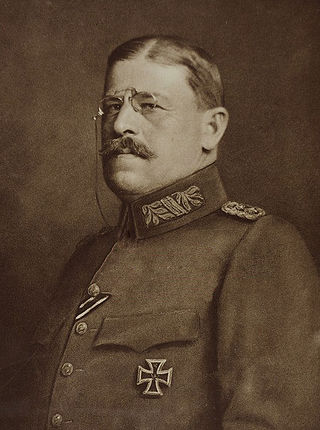
Baron is a rank of nobility or title of honour, often hereditary, in various European countries, either current or historical. The female equivalent is baroness. Typically, the title denotes an aristocrat who ranks higher than a lord or knight, but lower than a viscount or count. Often, barons hold their fief – their lands and income – directly from the monarch. Barons are less often the vassals of other nobles. In many kingdoms, they were entitled to wear a smaller form of a crown called a coronet.

August Wilhelm Antonius Graf Neidhardt von Gneisenau was a Prussian field marshal. He was a prominent figure in the reform of the Prussian military and the War of Liberation.

Freiherr, Freifrau and Freiin are designations used as titles of nobility in the German-speaking areas of the Holy Roman Empire and in its various successor states, including Austria, Prussia, Bavaria, Liechtenstein, Luxembourg, etc. Traditionally, it denotes the titled rank within the nobility above Ritter (knight) and Edler and below Graf. The title superseded the earlier medieval form, Edelherr.

Edwin Karl Rochus Freiherr von Manteuffel was a Prussian Generalfeldmarschall noted for his victories in the Franco-Prussian War, and the first Imperial Lieutenant of Alsace–Lorraine from 1879 until his death.

Edler was until 1919 the lowest rank of nobility in Austria-Hungary and Germany, just beneath a Ritter, but above untitled nobles, who used only the nobiliary particle von before their surname. It was mostly given to civil servants and military officers, as well as those upon whom the lower rank of an Order had been conferred. The noun Edler comes from the adjective edel ("noble"), and translated literally means "noble [person]". In accordance with the rules of German grammar, the word can also appear as Edle, Edlem, or Edlen depending on case, gender, and number.
Jonkheer is an honorific in the Low Countries denoting the lowest rank within the nobility. In the Netherlands, this in general concerns a prefix used by the untitled nobility. In Belgium, this is the lowest title within the nobility system, recognised by the Court of Cassation. It is the cognate and equivalent of the German noble honorific Junker, which was historically used throughout the German-speaking part of Europe, and to some extent also within Scandinavia.

The Royal Military Order of Saint George for the Defense of the Faith and the Immaculate Conception, also known as the Royal Bavarian House Equestrian Order of Saint George, was founded by Maximilian II Emanuel, Elector of Bavaria in 1729 to provide for a means of honouring the nobility and recognizing distinguished civil and military service.
The German nobility and royalty were status groups of the medieval society in Central Europe, which enjoyed certain privileges relative to other people under the laws and customs in the German-speaking area, until the beginning of the 20th century. Historically, German entities that recognized or conferred nobility included the Holy Roman Empire (962–1806), the German Confederation (1814–1866) and the German Empire (1871–1918). Chancellor Otto von Bismarck in the German Empire had a policy of expanding his political base by ennobling nouveau riche industrialists and businessmen who had no noble ancestors. The nobility flourished during the dramatic industrialization and urbanization of Germany after 1850. Landowners modernized their estates, and oriented their business to an international market. Many younger sons were positioned in the rapidly growing national and regional civil service bureaucracies, as well as in the officer corps of the military. They acquired not only the technical skills but the necessary education in high prestige German universities that facilitated their success. Many became political leaders of new reform organizations such as agrarian leagues, and pressure groups. The Roman Catholic nobility played a major role in forming the new Centre Party in resistance to Bismarck's anti-Catholic Kulturkampf, while Protestant nobles were similarly active in the Conservative Party.

The Military Order of Maria Theresa was the highest military honour of the Habsburg monarchy, Austrian Empire and Austro-Hungarian Empire.

Gustav Heine, after 1870 Gustav Freiherr Heine von Geldern, was a German-Austrian journalist and press publisher.

Hans Ritter von Adam, born Hans Adam, was a Bavarian flying ace in World War I, with 21 victories before being killed in action. He enlisted as an infantry private, and rose through the ranks to be commissioned an officer. His valor earned him his nation's highest awards, including one that posthumously raised him to nobility.

Jakob Ritter von Danner was a Bavarian general in the Imperial German Army and the Reichswehr. As commandant of the Munich garrison of the Reichswehr, he was a central figure in putting down the attempted Beer Hall Putsch by Adolf Hitler and the Nazis in 1923.

The Bavarian Military Merit Order was established on 19 July 1866 by King Ludwig II of Bavaria. It was the kingdom's main decoration for bravery and military merit for officers and higher-ranking officials. Civilians acting in support of the army were also made eligible for the decoration. The Military Merit Order ranked below the Military Order of Max Joseph (Militär-Max-Joseph-Orden), which was Bavaria's highest military honor for officers.

Eugen Siegfried Erich Ritter von Schobert was a German general during World War II. He commanded the 11th Army during Operation Barbarossa, the invasion of the Soviet Union. Schobert died when his observation plane crashed in a Soviet minefield.

The Military Order of Max Joseph was the highest military order of the Kingdom of Bavaria. It was founded on 1 January 1806 by Maximilian I Joseph of Bavaria, the first king of Bavaria. The order came in three classes:
Hans Ritter von Lex (1893-1970) was a German political figure and the President of the German Red Cross from 1961 to 1967. He was born Hans Lex on October 27, 1893, in Rosenheim, Upper Bavaria, Germany. He died February 26, 1970, in Munich, Germany.

Felix Ludwig Grafvon Bothmer was a German general from Bavaria. He notably served in the Brusilov offensive of World War I.

Oskar Ritter und Edlervon Xylander was a Bavarian General der Infanterie, at last commanding the I Royal Bavarian Corps until his retirement in 1918.

The Imperial Order of the Iron Crown was one of the highest orders of merit in the Austrian Empire and Austria-Hungary until 1918. It was founded in 1815 by Emperor Franz I of Austria as a re-establishment of the original Order of the Iron Crown, which previously had been an order of the Napoleonic Kingdom of Italy.
Karl Weber, from 1917 Ritter von Weber was a German officer, Major General and Commander of the 17th Panzer-Division of the German Army in World War II.
















